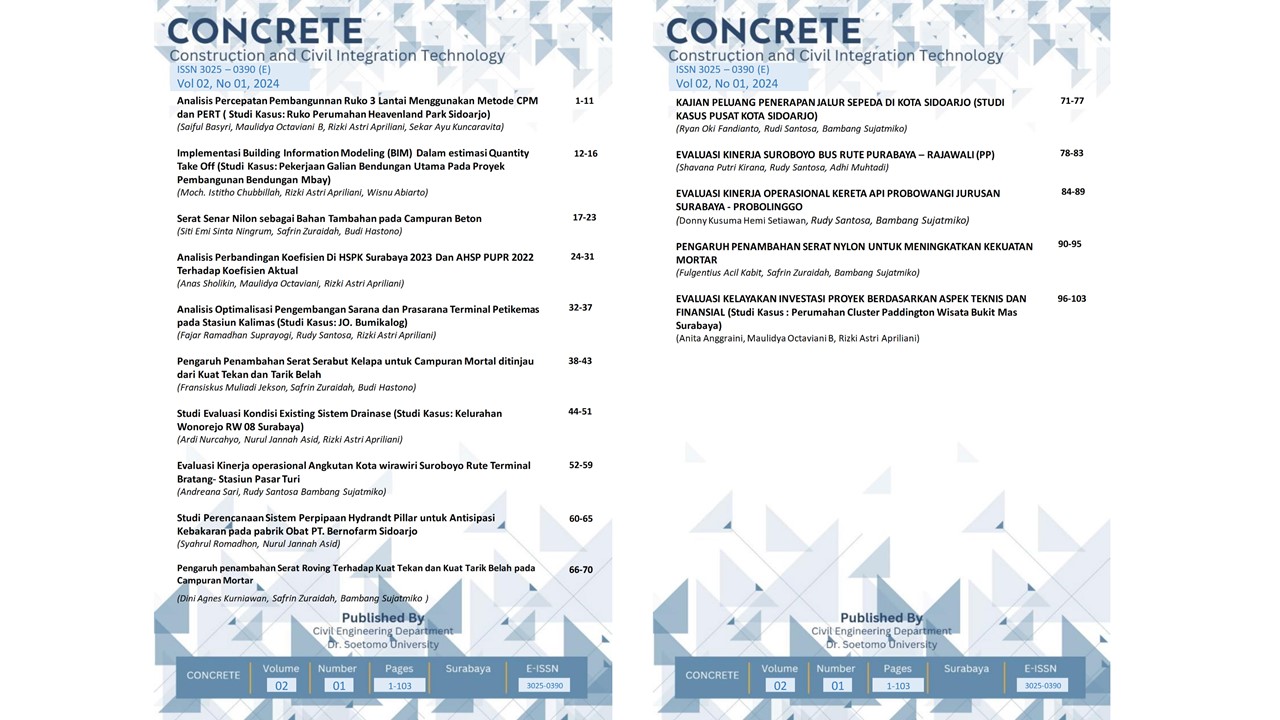EVALUASI KINERJA SUROBOYO BUS RUTE PURABAYA – RAJAWALI (PP)
PERFORMANCE EVALUATION OF THE SUROBOYO BUS ROUTE PURABAYA – RAJAWALI (PP)
 Abstract views: 171
,
Abstract views: 171
,
 pdf downloads: 166
pdf downloads: 166
Abstract
Suroboyo Bus is a public transportation company operating in the city of Surabaya, East Java. Founded in 2018, Suroboyo Bus aims to provide comfortable, safe and affordable transportation services for local residents and visitors to the city of Surabaya. The negative impact of increased movement is the emergence of traffic jams due to the dominant use of private vehicles. The Surabaya city government and the Ministry of Transportation worked together to produce the Suroboyo Bus as a solution to overcome traffic jams. Since the initial inauguration, bus operational conditions have not yet reached optimal performance. The aim of this research is to determine and evaluate the results of bus operational performance based on the SK.687/AJ206/DRJD/2002 guidelines. The method used is quantitative descriptive, namely collecting data in the field using dynamic surveys. The dynamic survey produces data on bus carrying capacity, number of passengers, travel time, stopping time, speed, headway and bus facilities. The results of the Suroboyo bus performance analysis based on the total bus carrying capacity is 67 people. In terms of load factor, the average Purabaya Rajawali PP is 0.55 on holidays and 0.69 on weekdays. The average travel time is 55 minutes, the bus travel speed is 25 km. / hour, the average headway of bus departures is 19 minutes, There are 2 operational study indicators that do not meet the standards, namely the load factor because people tend to use private vehicles and the headway which is sometimes long at certain hours because buses still use public lanes as their operating routes.
References
Adriana, M. C., Rizki, M., & Joewono, T. B. (2019). Investigating Satisfaction and Its Determinants of BRT-Lite Services in Indonesian Cities. Journal of the Eastern Asia Society for Transportation Studies, 13, 1447-1468.
Alfiansyah, R, “ Perencanaan Angkutan Bus Trayek Terminal Bubulak – Terminal Baranang Siang (lewat stasiun Bogor)”,2019.
Amiruddin,M. (2019). Pola Komunikasi Driver Ojek Online Grabbike Pada Pelayanan Custumer diKota Malang.
Badan Pusat Statistik. 2023. Proyeksi Penduduk Indonesia 2020-2050 Hasil Sensus Penduduk 2020.
Brovarone, E. V. (2020). Design as if bus stops mattered: exploring the potential role of public transport stops in the urban environment. URBAN DESIGN International, 26(1), 82-96.
Departemen Perhubungan RI. 2002. Jenderal Perhubungan Darat Nomor 274/HK.105/DRJD/96 tentang Pedoman Teknis Penyelenggaraan Angkutan Umum di Wilayah Perkotaan dalam Trayek Tetap dan Teratur. Direktorat Perhubungan Darat. Jakarta.
Deng, T., & Nelson, J. D. (2010). The impact of bus rapid transit on landdevelopment: A case study of Beijing, China. World Academy of Science, Engineering and Technology, 66(2010), 1196-1206.
Dipanegara, H,” Evaluasi Kinerja Bus Rapid Transit (BRT) Banjarbakula Pada Rute Wilayah Kota Banjarmasin,2020.
Hensher, D. A., & Golob, T. F. (2008). Bus rapid transit systems: a comparative assessment. Transportation, 35(4), 501-518.
Hilda ,E. A. (2021). Implikasi Ojek Online Terhadap Ojek Offline Perspektif Ekonomi Islam (Studi diSoreang Kota Parepare).
Kurnianingtyas, A,” Analisa Kinerja Bus Rapid Transit (BRT) Trans Semarang Koridor II Terminal Terboyo-Terminal Sisemut,2020.
Kurniawan, A.A, & Prabawati, I. (2018). Implementasi Suroboyo Bus Di Dinas Perhubungan Kota Surabaya.
Rabinovitch, J., & Hoehn, J. P. (1995). A Sustainable Urban Transportation System:The" surface Metro" in Curitiba, Brazil (No. 19). Environmental and Natural Resources Policy and Training Project.
Tiwari, Geetam (2006), Urban Passenger Transport: Framework for an OptimalModal Mix, New Delhi: Asian Development Bank, India Resident Mission (INRM).
Warpani, S. 1990. Merencanakan Sistem Perangkutan. Bandung: Penerbit ITB.
Widodo, A,”Analisa dan Evaluasi Sistem Transportasi Publik Bus Rapid Transit (BRT) Trans Semarang Koridor IV Kota Semarag”,2023.
Winaryo,B. M. Peran Pemerintah Kota Surabaya Dalam Pengaturan Transportasi Publik Kota Surabaya : Studi Perkotaan Program “Suroboyo Bus”,2019.
Wirasinghe S. C., Kattan L., Rahman M. M., Hubbell J., Thilakaratne R., & AnowarS. (2013). Bus rapid transit–a review, International Journal of Urban Sciences 17(1), 1-31.
Authors who publish with CONCRETE: Construction and Civil Integration Technology agree to the following terms:
- Authors retain copyright and grant the journal right of first publication with the work simultaneously licensed under a Creative Commons Attribution License (CC BY-SA 4.0) that allows others to share the work with an acknowledgment of the work's authorship and initial publication in this journal.
- Authors are able to enter into separate, additional contractual arrangements for the non-exclusive distribution of the journal's published version of the work (e.g., post it to an institutional repository or publish it in a book), with an acknowledgment of its initial publication in this journal.
- Authors are permitted and encouraged to post their work online (e.g., in institutional repositories or on their website) prior to and during the submission process, as it can lead to productive exchanges, as well as earlier and greater citation of published work.









